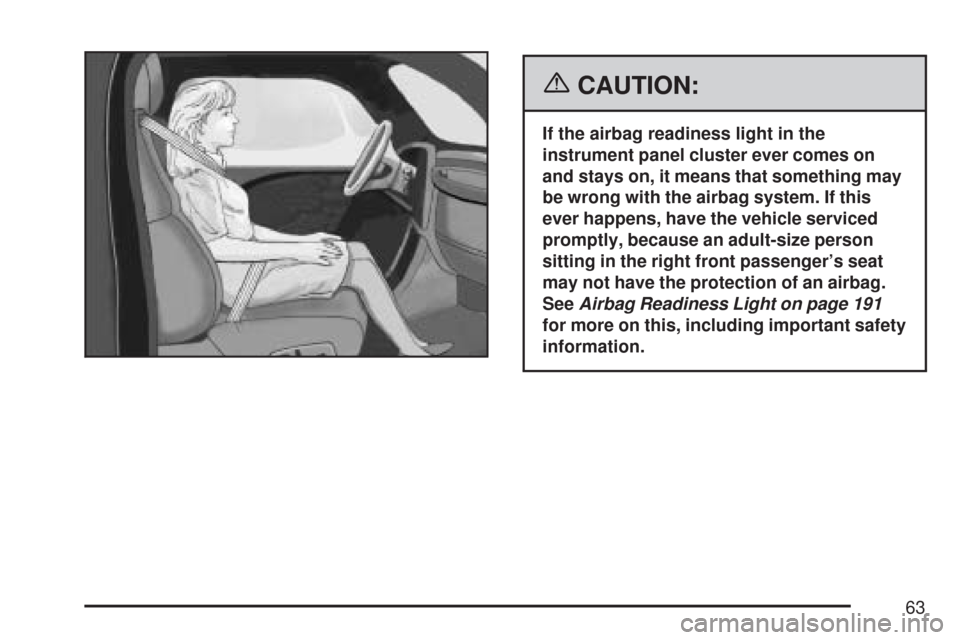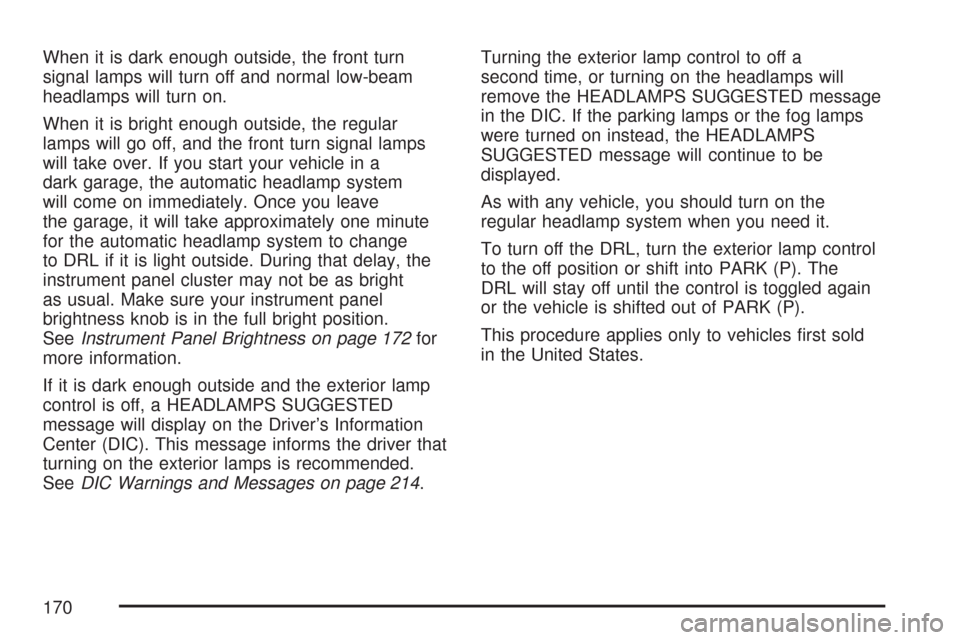2007 CHEVROLET CORVETTE instrument cluster
[x] Cancel search: instrument clusterPage 63 of 488

{CAUTION:
If the airbag readiness light in the
instrument panel cluster ever comes on
and stays on, it means that something may
be wrong with the airbag system. If this
ever happens, have the vehicle serviced
promptly, because an adult-size person
sitting in the right front passenger’s seat
may not have the protection of an airbag.
SeeAirbag Readiness Light on page 191
for more on this, including important safety
information.
63
Page 153 of 488

Instrument Panel Overview........................ 156
Hazard Warning Flashers.......................... 158
Other Warning Devices............................. 159
Horn.......................................................... 159
Tilt Wheel.................................................. 159
Turn Signal/Multifunction Lever.................. 160
Turn and Lane-Change Signals
(Auto Signal).......................................... 161
Headlamp High/Low-Beam Changer.......... 162
Flash-to-Pass............................................ 162
Windshield Wipers..................................... 162
Windshield Washer.................................... 163
Cruise Control........................................... 164
Exterior Lamps.......................................... 168
Wiper Activated Headlamps....................... 169
Headlamps on Reminder........................... 169
Daytime Running Lamps (DRL)................. 169
Fog Lamps................................................ 171
Twilight Sentinel
®...................................... 171
Exterior Lighting Battery Saver.................. 172
Instrument Panel Brightness...................... 172
Courtesy Lamps........................................ 173
Entry/Exit Lighting...................................... 173
Reading Lamps......................................... 173
Battery Run-Down Protection..................... 173Head-Up Display (HUD)............................ 174
Accessory Power Outlet(s)........................ 178
Ashtray(s) and Cigarette Lighter................ 179
Climate Controls......................................... 179
Dual Automatic Climate Control System.... 179
Outlet Adjustment...................................... 186
Passenger Compartment Air Filter............. 186
Warning Lights, Gages, and Indicators..... 188
Instrument Panel Cluster........................... 189
Speedometer and Odometer...................... 190
Tachometer............................................... 190
Safety Belt Reminder Light........................ 190
Airbag Readiness Light............................. 191
Passenger Airbag Status Indicator............. 192
Voltmeter Gage......................................... 194
One-to-Four Shift Light
(Manual Transmission)........................... 195
Brake System Warning Light..................... 196
Anti-Lock Brake System Warning Light...... 197
Traction Control System (TCS)
Warning Light........................................ 197
Active Handling System Light.................... 198
Engine Coolant Temperature Gage............ 199
Section 3 Instrument Panel
153
Page 157 of 488

The main components of your instrument panel are the following:
A. Air Outlet. SeeOutlet Adjustment on page 186.
B. Head-Up Display Controls (If Equipped).
SeeHead-Up Display (HUD) on page 174.
C. Turn Signal/Multifunction Lever. SeeTurn
Signal/Multifunction Lever on page 160. Cruise
Control. SeeCruise Control on page 164.
Fog Lamps. SeeFog Lamps on page 171.
Headlamp Controls. SeeExterior Lamps
on page 168.
D. Manual Shift Paddles (If Equipped). See
Automatic Transmission Operation on page 95.
E. Driver Information Center (DIC). SeeDriver
Information Center (DIC) on page 207.
F. Instrument Panel Cluster. SeeInstrument
Panel Cluster on page 189.
G. Audio Steering Wheel Controls (If Equipped).
SeeAudio Steering Wheel Controls on
page 269.
H. Windshield Wiper/Washer Lever. See
Windshield Wipers on page 162and
Windshield Washer on page 163.
I. Driver Information Center (DIC) Controls.
SeeDIC Controls and Displays on page 208.J. Center Air Outlets. SeeOutlet Adjustment
on page 186.
K. Hazard Warning Flasher Button. SeeHazard
Warning Flashers on page 158.
L. Audio System. SeeAudio System(s) on
page 244.
M. Climate Controls. SeeDual Automatic Climate
Control System on page 179.
N. Fuel Door Release Button. SeeFilling the Tank
on page 324. Hatch/Trunk Release Button.
See “Hatch/Trunk Lid Release” under
Hatch/Trunk on page 82.
O. Instrument Panel Brightness Control. See
Instrument Panel Brightness on page 172.
P. Power Folding Top Switch (If Equipped).
SeeConvertible Top (Manual) on page 139
orConvertible Top (Power) on page 146.
Q. Tilt Wheel Lever. SeeTilt Wheel on page 159.
R. Telescopic Wheel Button (If Equipped).
SeeTilt Wheel on page 159.
S. Ignition Switch. SeeIgnition Positions
on page 90.
157
Page 161 of 488

ICruise Control. SeeCruise Control
on page 164.
PExterior Lamps Control. SeeExterior
Lamps on page 168.
Turn and Lane-Change Signals
(Auto Signal)
The turn signal has two upward (for right) and
two downward (for left) positions. These positions
allow you to signal a turn or a lane change.
To signal a turn, move the multifunction lever all
the way up or down. When the turn is �nished,
the lever will return automatically.
An arrow on the
instrument panel
cluster will �ash in
the direction of the
turn or lane change.To signal a lane change, just raise or lower the
lever until the arrow starts to �ash. Release
the lever and the turn signal will automatically �ash
three times. If more �ashes are desired, continue
to hold the lever.
If you signal a turn or a lane change and the
arrows �ash faster than normal, a signal bulb may
be burned out.
If a bulb is burned out, replace it to help avoid an
accident. If the arrows do not go on at all when
you signal a turn, check the fuses and check
for burned-out bulbs. SeeFuses and Circuit
Breakers on page 419.
Turn Signal on Chime
A chime will remind you if you leave the turn
signal on for more than three-quarters of a mile
(1.2 km) of driving.
If you need to leave the turn signal on for more
than three-quarters of a mile (1.2 km), turn off the
signal and then turn it back on.
161
Page 162 of 488

Headlamp High/Low-Beam Changer
To change the headlamps from low beam to
high, push the turn signal lever all the way forward.
To change from high to low beam, pull the lever
rearward.
While the high beams
are on, this light on
the instrument panel
cluster will also be lit.
Flash-to-Pass
To use the �ash-to-pass feature, brie�y pull the
turn signal lever toward you. The high-beam
indicator �ashes to indicate to the other driver that
you intend to pass. If the low-beam headlamps
are off and the fog lamps are on, the fog
lamps �ash.
Windshield Wipers
Use the lever located on the right side of the
steering column to operate the windshield wipers.
1(High Speed):Move the lever to this
position for steady wiping at high speed.
6(Low Speed):Move the lever to this
position for steady wiping at low speed.
&(Delay):Move the lever to this position to
set a delay between wipes.
162
Page 170 of 488

When it is dark enough outside, the front turn
signal lamps will turn off and normal low-beam
headlamps will turn on.
When it is bright enough outside, the regular
lamps will go off, and the front turn signal lamps
will take over. If you start your vehicle in a
dark garage, the automatic headlamp system
will come on immediately. Once you leave
the garage, it will take approximately one minute
for the automatic headlamp system to change
to DRL if it is light outside. During that delay, the
instrument panel cluster may not be as bright
as usual. Make sure your instrument panel
brightness knob is in the full bright position.
SeeInstrument Panel Brightness on page 172for
more information.
If it is dark enough outside and the exterior lamp
control is off, a HEADLAMPS SUGGESTED
message will display on the Driver’s Information
Center (DIC). This message informs the driver that
turning on the exterior lamps is recommended.
SeeDIC Warnings and Messages on page 214.Turning the exterior lamp control to off a
second time, or turning on the headlamps will
remove the HEADLAMPS SUGGESTED message
in the DIC. If the parking lamps or the fog lamps
were turned on instead, the HEADLAMPS
SUGGESTED message will continue to be
displayed.
As with any vehicle, you should turn on the
regular headlamp system when you need it.
To turn off the DRL, turn the exterior lamp control
to the off position or shift into PARK (P). The
DRL will stay off until the control is toggled again
or the vehicle is shifted out of PARK (P).
This procedure applies only to vehicles �rst sold
in the United States.
170
Page 171 of 488

Fog Lamps
Use fog lamps for better vision in foggy or misty
conditions.
The fog lamps control is located on the
multifunction lever next to the exterior lamp
control.
-(Fog Lamps):Turning the band to this
position will turn the fog lamps on.
When you turn the fog lamps on, the fog lamp
light will appear on the instrument panel cluster
to indicate that the fog lamps and the parking
lamps are on.
If you turn the high-beam headlamps on, the
fog lamps will turn off. They will turn on again
when you switch to low-beam headlamps.
The ignition must be on for the fog lamps to
operate.
Some localities have laws that require the
headlamps to be on along with the fog lamps.
Twilight Sentinel®
Twilight Sentinel®can turn your lamps on and off
for you. A light sensor on top of the instrument
panel makes the Twilight Sentinel
®work, so
be sure it is not covered.
With Twilight Sentinel
®, you will see the following
happen:
When it is dark enough outside, the front
turn signal lamps (DRL) will go off, and
the headlamps and parking lamps will come
on. The other lamps that come on with
headlamps will also come on.
When it is bright enough outside, the
headlamps will go off, and the front turn signal
lamps (DRL) will come on, as long as the
exterior lamp switch is in the AUTO position.
If you start your vehicle in a dark garage, the
automatic headlamp system will come on
immediately. Once you leave the garage, it will
take about one minute for the automatic headlamp
system to change to DRL if it is light outside. During
that delay, your instrument panel cluster may not
be as bright as usual. Make sure your instrument
panel brightness control is in full bright position.
SeeInstrument Panel Brightness on page 172.
171
Page 174 of 488

Head-Up Display (HUD)
{CAUTION:
If the HUD image is too bright, or too
high in your �eld of view, it may take you
more time to see things you need to see
when it is dark outside. Be sure to keep
the HUD image dim and placed low in your
�eld of view.
If your vehicle has the Head-Up Display (HUD), you
can see some of the driver information that appears
on the instrument panel cluster.
The information may be displayed in English or
metric units and appears as an image focused out
toward the front of your vehicle. The HUD consists
of the following information:
Speedometer
Turn Signal Indicators
High-Beam Indicator Symbol
Tachometer
Manual Paddle Shift Gear Indicator
(If Equipped)
These displays on the HUD are for use when
using the manual paddle shift controls to shift
the transmission. See “Manual Paddle Shift” in
Automatic Transmission Operation on page 95.
Shift Light
This light is used for performance driving to
indicate that the vehicle’s best performance
level has been reached to shift the transmission
into the next higher gear. An arrow pointing up
will light up on the display just prior to reaching
the engine fuel cut-off mode. This cut-off is
about 6,500 RPM for the LS2 engine and
7,000 RPM for the LS7 engine.
Check Gages Warning
Engine Coolant Temperature Gage
Transmission Fluid Temperature Gage,
(Automatic Transmission Vehicles Only)
Engine Oil Temperature Gage
Engine Oil Pressure Gage
G-Force Gage
Audio Functions, Street Mode Only
Navigation, Only with Navigation Radio,
Turn-by-Turn Guidance
174